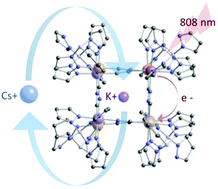A new {Fe4Co4} soluble switchable nanomagnet encapsulating Cs+: enhancing the stability and redox flexibility and tuning the photomagnetic effect.†‡
Abstract
We report a new cyanide-bridged Cs⊂{Fe4Co4} box, a soluble model of photomagnetic Prussian blue analogues (PBAs). The Cs+ ion has a high affinity for the box and can replace the K+ ion in the preformed K-cube. This exchange is kinetically impeded at room temperature but is accelerated by heating and using the 18-crown-6 ether. The inserted Cs+ ion confers a high robustness to the cube, which withstands boiling, as shown by variable-temperature NMR studies. The stability of this model complex in solution allows the probing of the electronic interaction between the alkali ion and the cyanide cage by using various techniques. These interactions are known to play a role in the photomagnetic behaviour of PBAs. Firstly, the 133Cs NMR spectroscopy proves that there is an electronic communication between the encapsulated alkali ion and the cyanide cage. The measured up-field signal, observed at ca. −200 ppm at 300 K, reveals that a certain amount of spin density is transferred through the bonds from the paramagnetic Co(II) ion to the encapsulated cation. Secondly, cyclovoltammetric studies show that the nature of the inserted ions affects the redox properties of the cage and influences the electronic communication between the metal ions. However, the differences in the electrochemical properties of the K-cube and the Cs-cube remain moderate. As the switching properties are influenced by the redox potential of the Fe and Co centers, similar photomagnetic behaviour is observed, with both of them being highly photomagnetic. This result contrasts strikingly with previous studies on the 3D polymeric PBAs, where the PBAs with a high amount of Cs+ show poor photomagnetic behaviour. In that case, cooperative behaviour likely influences the switching properties. Finally, EPR spectroscopy shows that the K-cube is more anisotropic than the Cs-cube. This difference is reflected in the changes occurring in the slow magnetic relaxation (single molecule magnet behaviour) observed in the two cubes.



 Please wait while we load your content...
Please wait while we load your content...